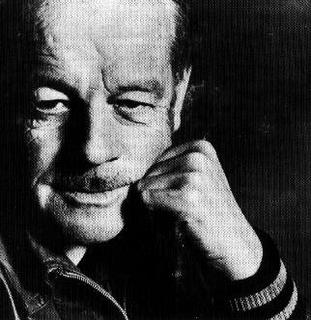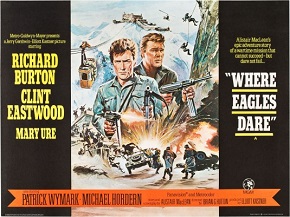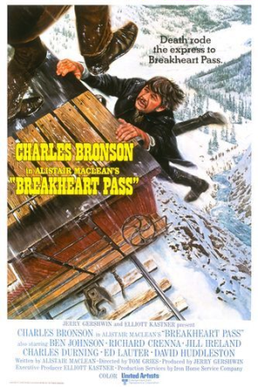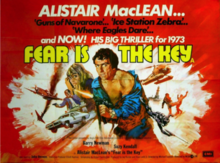
Alistair Stuart MacLean was a Scottish novelist who wrote popular thrillers and adventure stories. Many of his novels have been adapted to film, most notably The Guns of Navarone (1957) and Ice Station Zebra (1963). In the late 1960s, encouraged by film producer Elliott Kastner, MacLean began to write original screenplays, concurrently with an accompanying novel. The most successful was the first of these, the 1968 film Where Eagles Dare, which was also a bestselling novel. MacLean also published two novels under the pseudonym Ian Stuart. His books are estimated to have sold over 150 million copies, making him one of the best-selling fiction authors of all time.

Where Eagles Dare is a 1968 action adventure war thriller spy film directed by Brian G. Hutton and starring Richard Burton, Clint Eastwood and Mary Ure. It follows a Special Operations Executive team of men attempting to save a captured American General from the fictional Schloß Adler fortress, except the mission turns out not to be as it seems. It was filmed in Panavision using the Metrocolor process, and was distributed by Metro-Goldwyn-Mayer. Alistair MacLean wrote the screenplay, his first, at the same time that he wrote the novel of the same name. Both became commercial successes.

Robbery is a 1967 British crime film directed by Peter Yates and starring Stanley Baker, Joanna Pettet and James Booth. The story is a heavily fictionalised version of the 1963 Great Train Robbery. The film was produced by Stanley Baker and Michael Deeley, for Baker's company Oakhurst Productions.
Elliott Kastner was an American film producer, whose best known credits include Where Eagles Dare (1968), The Long Goodbye (1973), The Missouri Breaks (1976), and Angel Heart (1987).

Mona Lee Washbourne was an English actress of stage, film, and television. Her most critically acclaimed role was in the film Stevie (1978), late in her career, for which she was nominated for a Golden Globe Award and a BAFTA Award.

Hell Drivers (1957) is a British film noir crime drama film directed by Cy Endfield and starring Stanley Baker, Herbert Lom, Peggy Cummins and Patrick McGoohan. The film was produced by the Rank Organisation and Aqua Film Productions. A recently released convict takes a driver's job at a haulage company and encounters violence and corruption.

Fear Is the Key is a 1961 first-person narrative thriller novel by Scottish author Alistair MacLean.

Sword of Sherwood Forest is a 1960 British Eastman Color adventure film in MegaScope directed by Terence Fisher and starring Richard Greene, Peter Cushing, Niall MacGinnis and Sarah Branch. Greene reprises the role of Robin Hood, which he played in The Adventures of Robin Hood TV series 1955–1959. It was produced by Sidney Cole and Greene for Hammer Film Productions.

Harper is a 1966 American mystery thriller film directed by Jack Smight from a screenplay by William Goldman, based on the 1949 novel The Moving Target by Ross Macdonald. The film stars Paul Newman as Lew Harper, with a cast that includes Lauren Bacall, Julie Harris, Arthur Hill, Janet Leigh, Pamela Tiffin, Robert Wagner, and Shelley Winters.

Seven Days to Noon is a 1950 British political thriller film. It was directed by John and Roy Boulting and it starred Barry Jones.

Seawitch is a novel written by the Scottish author Alistair MacLean. It was first released in the United Kingdom by Collins in 1977 and later in the same year by Doubleday in the United States.

The Way to Dusty Death is a thriller novel written by Scottish author Alistair MacLean. It was originally published in 1973. The title is a quotation from the famous soliloquy in Act 5, Scene 5 in Shakespeare’s play Macbeth.

Caravan to Vaccarès is a novel by author Alistair MacLean, originally published in 1970. This novel is set in the Provence region of southern France. The novel was originally written as a screenplay for producer Elliot Kastner.

When Eight Bells Toll is a 1971 action film directed by Étienne Périer and starring Anthony Hopkins, Jack Hawkins, Robert Morley, and Nathalie Delon. Set in Scotland, it is based upon Scottish author Alistair MacLean's 1965 novel of the same name. Producer Elliott Kastner planned to produce a string of realistic gritty espionage thrillers to rival the James Bond series, but the film's poor box office receipts ended his plans.

Breakheart Pass is a 1975 American Western film that stars Charles Bronson, Ben Johnson, Richard Crenna, and Jill Ireland. Based on the 1974 novel of the same title by Scottish author Alistair MacLean (1922–1987), it was filmed in north-central Idaho.

The Hostage Tower is a 1980 American spy and thriller television film starring Peter Fonda and Douglas Fairbanks Jr., and directed by Claudio Guzmán, well known for his work in sitcoms. It is based on a story by Alistair MacLean. A book based on MacLean's story by John Denis was the first in the series of UNACO books.

Dancing with Crime is a 1947 British film noir film directed by John Paddy Carstairs, starring Richard Attenborough, Barry K. Barnes and Sheila Sim. A man hunts down the killer of his lifelong friend.

The Brain, also known as Vengeance and Ein Toter sucht seinen Mörder, is a 1962 UK-West German co-production science fiction thriller film directed by Freddie Francis, and starring Anne Heywood and Peter van Eyck. It is adapted from the 1942 Curt Siodmak novel Donovan's Brain, and in this film, differing from earlier adaptations, the dead man seeks his murderer through hypnotic contact with the doctor keeping his brain alive.

Puppet on a Chain is a 1970 British thriller film directed by Geoffrey Reeve and starring Sven-Bertil Taube, Barbara Parkins and Alexander Knox. It is based on the 1969 novel Puppet on a Chain by Alistair MacLean.
Fear Is the Key may refer to:

















